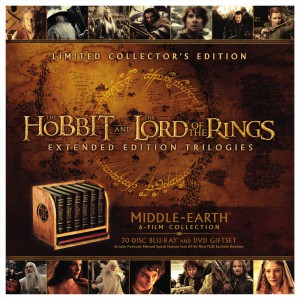 No-one likes being taken for a sucker. And, frankly, the recent announcement of the Middle-earth blockbuster ka-pow edition (or whatever jargon-hype wording Warner Bros Home Entertainment is lobbing onto it) certainly has that feel.
No-one likes being taken for a sucker. And, frankly, the recent announcement of the Middle-earth blockbuster ka-pow edition (or whatever jargon-hype wording Warner Bros Home Entertainment is lobbing onto it) certainly has that feel.
It’s the same content repackaged into a bookcase that you or I might have thrown together in high-school woodworking. Yes the bookcase looks quite nice. And there’s a nice little booklet. Yes, all your discs come in nice faux-leather slipcases. Yes, it’s all in a big, glossy box created by professional designers (even if they’re using the same visual assets we’ve seen elventy-billion times).
But, ultimately, it’s still the same content.
And for eight hundred US dollars. Count them.
It’s often said there’s a sucker born every minute, (a quote often, and most probably falsely, atributed to PT Barnum) and with this announcement it feels as though Warner Bros is on the hunt for them in Middle-earth fandom.
Yet, as much as it pains me to say this, (because I find the relentless franchising of Hollywood crass and feel that it is ultimately detrimental to the creative appeal and credibility of the works it is producing) something doesn’t quite feel right here.
I’m not certain there’s actually a lot of money to be made here.
Let’s face it, the Limited Collector’s Edition is a niche product. Even the most optimistic of Warner Bros executives would realise this. They can’t be expecting to shift hundreds of thousands of these suckers.
Realising this, I started trying to dig up some numbers and work out how much profit they might expect to gross. Will they really raking in Smaug-hoard-sized loads of cash here?
Smaug-hoard-sized loads of cash?
First I headed to a site run by Nash Information Services LLC, a company which provides analytical services on and for the movie industry — and which attempts (see bootnote at bottom) to track blu-ray sales within the USA market.
According to their research, The Hobbit: An Unexpected Journey has shifted a total of 3,513,743 since March 9, 2013. The Hobbit: The Desolation of Smaug has shifted a little less: 2,423,137 since its debut.
This might be a good proxy number to start from for the size of the potential market.
Would a box set sell even 10% of that number? That seems quite unlikely given the lack of new content, the various iteration of extended edition collectors editions that already exist, and a tear-inducing price tag that will inevitably soften demand.
Would it sell 1% of that number? Let’s say that’s not impossible.
So, 0.01 x 3.5 million = 35,000 sales.
I dunno: seems a lot for a high-end collector product but let’s roll with it.
The other part of the question is mark-up. We know the recommended retail price is $800. But WB doesn’t get all of that.
A retailer margin might be around 50%? That gives the retailer $267 per unit, leaving $533 for Warner Bros. But Warner Bros has costs, too. A bit of research suggests a reasonable wholesaler markup is about 20% — suggesting Warner Bros might make about $110 per unit.
I’m sure you can do the maths as easily as me from here. Assuming these numbers are roughly good, Warner Bros could make around $3,850,000 profit.
Now that’s more money than I’ve ever seen in one place. Probably more than you have too. But what about for Warner Bros?
Warner Bros 2015 earnings before interest and taxes was a whopping $1,416,000,000. (That’s $1.416 billion.)
So lets assume everything else stayed static for the next financial year. This box set pushes that profit to 1,419,000,000 — an immense 0.21% increase in profit.
This little endeavour probably won’t add even half a percent to Warner Bros bottom line (and even less to parent company Time Warner). And it won’t do so even if you assumed that the rest of the world was able to double those sales figures.
As much as I’d like to hector Warner Bros for squeezing the fan cow, there just doesn’t seem to be that much to be squeezed here.
It’s drop in the ocean stuff for them.

It might be worth a bit more to subsidiary division Warner Bros Home Entertainment, though.
Anyone who’s worked in a large organisation will be aware of the phenomemon of siloing, and how units inside very large corporations tend to work to protect their own patch and their own people.
It’s still not long ago that Warner Bros axed 10% of its employees. Perhaps Warner Bros Home Entertainment execs are looking to exploit low-hanging fruit to justify the employment of people dedicated to producing physical products in an era where video-on-demand is making inroads. (Yes, I know, Game of Thrones box set sales … but statistical outlier much?)
Maybe it’s really about company politics. Just a thought.
Bootnote: If anyone has more accurate figures, I’d love to see them. Studios are notorious for keeping DVD and blu-ray sales figures as secret as possible. If there are any errors in my numbers, drop a note in the comments.
Demosthenes has been an incredibly nerdy staff member at TheOneRing.net since 2001. The views in this article are his own, and do not necessarily represent those of other TORn staff.


